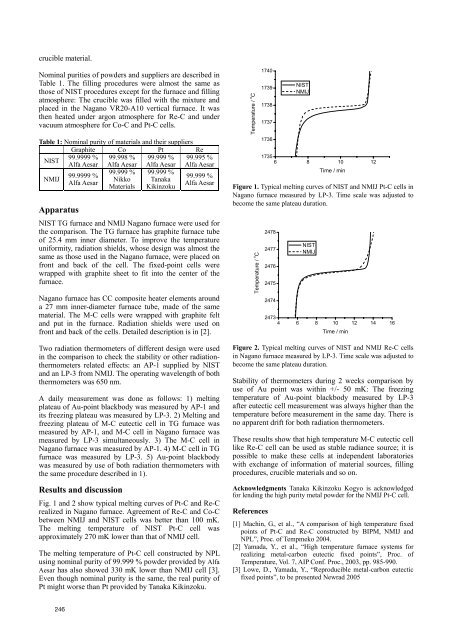Here - PMOD/WRC
Here - PMOD/WRC
Here - PMOD/WRC
You also want an ePaper? Increase the reach of your titles
YUMPU automatically turns print PDFs into web optimized ePapers that Google loves.
crucible material.<br />
Nominal purities of powders and suppliers are described in<br />
Table 1. The filling procedures were almost the same as<br />
those of NIST procedures except for the furnace and filling<br />
atmosphere: The crucible was filled with the mixture and<br />
placed in the Nagano VR20-A10 vertical furnace. It was<br />
then heated under argon atmosphere for Re-C and under<br />
vacuum atmosphere for Co-C and Pt-C cells.<br />
Table 1: Nominal purity of materials and their suppliers<br />
Graphite Co Pt Re<br />
NIST<br />
99.9999 % 99.998 % 99.999 %<br />
Alfa Aesar Alfa Aesar Alfa Aesar<br />
NMIJ<br />
99.999 % 99.999 %<br />
99.9999 %<br />
Nikko Tanaka<br />
Alfa Aesar<br />
Materials Kikinzoku<br />
Apparatus<br />
99.995 %<br />
Alfa Aesar<br />
99.999 %<br />
Alfa Aesar<br />
NIST TG furnace and NMIJ Nagano furnace were used for<br />
the comparison. The TG furnace has graphite furnace tube<br />
of 25.4 mm inner diameter. To improve the temperature<br />
uniformity, radiation shields, whose design was almost the<br />
same as those used in the Nagano furnace, were placed on<br />
front and back of the cell. The fixed-point cells were<br />
wrapped with graphite sheet to fit into the center of the<br />
furnace.<br />
Nagano furnace has CC composite heater elements around<br />
a 27 mm inner-diameter furnace tube, made of the same<br />
material. The M-C cells were wrapped with graphite felt<br />
and put in the furnace. Radiation shields were used on<br />
front and back of the cells. Detailed description is in [2].<br />
Two radiation thermometers of different design were used<br />
in the comparison to check the stability or other radiationthermometers<br />
related effects: an AP-1 supplied by NIST<br />
and an LP-3 from NMIJ. The operating wavelength of both<br />
thermometers was 650 nm.<br />
A daily measurement was done as follows: 1) melting<br />
plateau of Au-point blackbody was measured by AP-1 and<br />
its freezing plateau was measured by LP-3. 2) Melting and<br />
freezing plateau of M-C eutectic cell in TG furnace was<br />
measured by AP-1, and M-C cell in Nagano furnace was<br />
measured by LP-3 simultaneously. 3) The M-C cell in<br />
Nagano furnace was measured by AP-1. 4) M-C cell in TG<br />
furnace was measured by LP-3. 5) Au-point blackbody<br />
was measured by use of both radiation thermometers with<br />
the same procedure described in 1).<br />
Results and discussion<br />
Fig. 1 and 2 show typical melting curves of Pt-C and Re-C<br />
realized in Nagano furnace. Agreement of Re-C and Co-C<br />
between NMIJ and NIST cells was better than 100 mK.<br />
The melting temperature of NIST Pt-C cell was<br />
approximately 270 mK lower than that of NMIJ cell.<br />
The melting temperature of Pt-C cell constructed by NPL<br />
using nominal purity of 99.999 % powder provided by Alfa<br />
Aesar has also showed 330 mK lower than NMIJ cell [3].<br />
Even though nominal purity is the same, the real purity of<br />
Pt might worse than Pt provided by Tanaka Kikinzoku.<br />
Temperature / o C<br />
Figure 1. Typical melting curves of NIST and NMIJ Pt-C cells in<br />
Nagano furnace measured by LP-3. Time scale was adjusted to<br />
become the same plateau duration.<br />
Temperature / o C<br />
1740<br />
1739<br />
1738<br />
1737<br />
1736<br />
Figure 2. Typical melting curves of NIST and NMIJ Re-C cells<br />
in Nagano furnace measured by LP-3. Time scale was adjusted to<br />
become the same plateau duration.<br />
Stability of thermometers during 2 weeks comparison by<br />
use of Au point was within +/- 50 mK: The freezing<br />
temperature of Au-point blackbody measured by LP-3<br />
after eutectic cell measurement was always higher than the<br />
temperature before measurement in the same day. There is<br />
no apparent drift for both radiation thermometers.<br />
These results show that high temperature M-C eutectic cell<br />
like Re-C cell can be used as stable radiance source; it is<br />
possible to make these cells at independent laboratories<br />
with exchange of information of material sources, filling<br />
procedures, crucible materials and so on.<br />
Acknowledgments Tanaka Kikinzoku Kogyo is acknowledged<br />
for lending the high purity metal powder for the NMIJ Pt-C cell.<br />
References<br />
1735<br />
6 8 10 12<br />
2478<br />
2477<br />
2476<br />
2475<br />
2474<br />
NIST<br />
NMIJ<br />
NIST<br />
NMIJ<br />
Time / min<br />
2473<br />
4 6 8 10 12 14 16<br />
Time / min<br />
[1] Machin, G., et al., “A comparison of high temperature fixed<br />
points of Pt-C and Re-C constructed by BIPM, NMIJ and<br />
NPL”, Proc. of Tempmeko 2004.<br />
[2] Yamada, Y., et al., “High temperature furnace systems for<br />
realizing metal-carbon eutectic fixed points”, Proc. of<br />
Temperature, Vol. 7, AIP Conf. Proc., 2003, pp. 985-990.<br />
[3] Lowe, D., Yamada, Y., “Reproducible metal-carbon eutectic<br />
fixed points”, to be presented Newrad 2005<br />
246
















